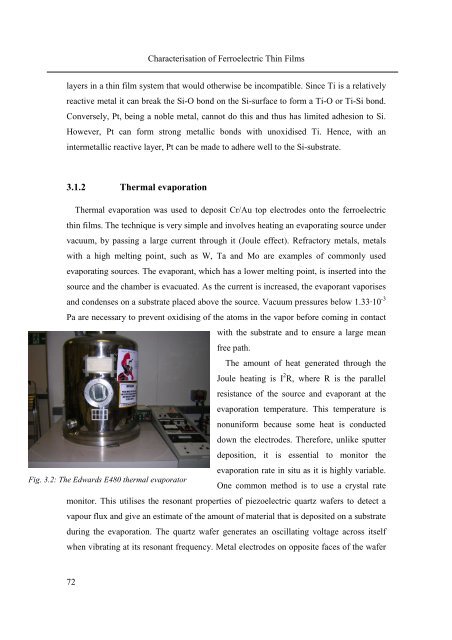PhD Thesis Arne Lüker final version V4 - Cranfield University
PhD Thesis Arne Lüker final version V4 - Cranfield University
PhD Thesis Arne Lüker final version V4 - Cranfield University
You also want an ePaper? Increase the reach of your titles
YUMPU automatically turns print PDFs into web optimized ePapers that Google loves.
72<br />
Characterisation of Ferroelectric Thin Films<br />
layers in a thin film system that would otherwise be incompatible. Since Ti is a relatively<br />
reactive metal it can break the Si-O bond on the Si-surface to form a Ti-O or Ti-Si bond.<br />
Conversely, Pt, being a noble metal, cannot do this and thus has limited adhesion to Si.<br />
However, Pt can form strong metallic bonds with unoxidised Ti. Hence, with an<br />
intermetallic reactive layer, Pt can be made to adhere well to the Si-substrate.<br />
3.1.2 Thermal evaporation<br />
Thermal evaporation was used to deposit Cr/Au top electrodes onto the ferroelectric<br />
thin films. The technique is very simple and involves heating an evaporating source under<br />
vacuum, by passing a large current through it (Joule effect). Refractory metals, metals<br />
with a high melting point, such as W, Ta and Mo are examples of commonly used<br />
evaporating sources. The evaporant, which has a lower melting point, is inserted into the<br />
source and the chamber is evacuated. As the current is increased, the evaporant vaporises<br />
and condenses on a substrate placed above the source. Vacuum pressures below 1.33·10 -3<br />
Pa are necessary to prevent oxidising of the atoms in the vapor before coming in contact<br />
Fig. 3.2: The Edwards E480 thermal evaporator<br />
with the substrate and to ensure a large mean<br />
free path.<br />
The amount of heat generated through the<br />
Joule heating is I 2 R, where R is the parallel<br />
resistance of the source and evaporant at the<br />
evaporation temperature. This temperature is<br />
nonuniform because some heat is conducted<br />
down the electrodes. Therefore, unlike sputter<br />
deposition, it is essential to monitor the<br />
evaporation rate in situ as it is highly variable.<br />
One common method is to use a crystal rate<br />
monitor. This utilises the resonant properties of piezoelectric quartz wafers to detect a<br />
vapour flux and give an estimate of the amount of material that is deposited on a substrate<br />
during the evaporation. The quartz wafer generates an oscillating voltage across itself<br />
when vibrating at its resonant frequency. Metal electrodes on opposite faces of the wafer

















